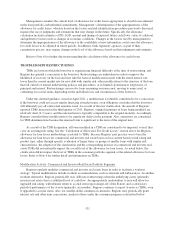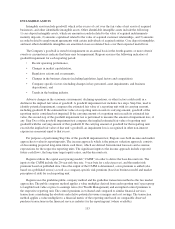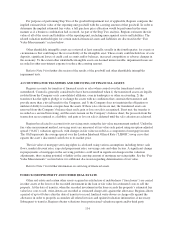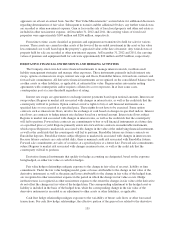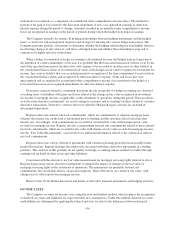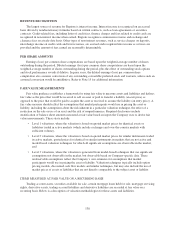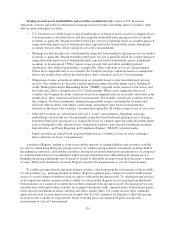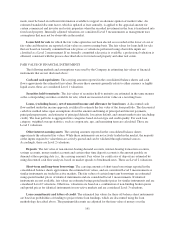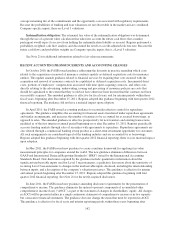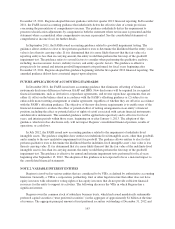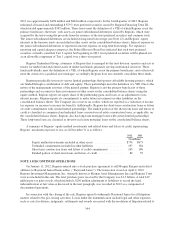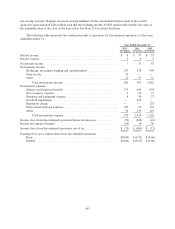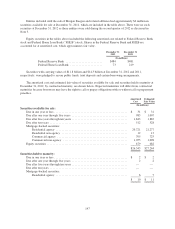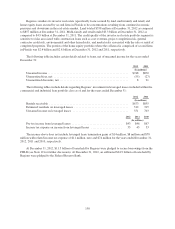Regions Bank 2012 Annual Report Download - page 156
Download and view the complete annual report
Please find page 156 of the 2012 Regions Bank annual report below. You can navigate through the pages in the report by either clicking on the pages listed below, or by using the keyword search tool below to find specific information within the annual report.Mortgage loans held for sale consist of residential first mortgage loans held for sale that are valued based
on traded market prices of similar assets where available and/or discounted cash flows at market interest rates,
adjusted for securitization activities that include servicing value and market conditions, a Level 2 measurement.
Regions has elected to measure certain mortgage loans held for sale at fair value by applying the fair value option
(see additional discussion under the “Fair Value Option” section in Note 21).
Mortgage servicing rights consist of residential mortgage servicing rights and are valued using an option-
adjusted spread valuation approach, a Level 3 measurement. The underlying assumptions and estimated values
are periodically corroborated by values received from an independent third party. See Note 7 for information
regarding the servicing of financial assets and additional details regarding the assumptions relevant to this
valuation.
Derivative assets and liabilities, which primarily consist of interest rate contracts that include futures,
options and swaps, are included in other assets and other liabilities (as applicable) on the consolidated balance
sheets. Interest rate swaps are predominantly traded in over-the-counter markets and, as such, values are
determined using widely accepted discounted cash flow models, which are Level 2 measurements. These
discounted cash flow models use projections of future cash payments/receipts that are discounted at mid-market
rates. The assumed cash flows are sourced from an assumed yield curve, which is consistent with industry
standards and conventions. These valuations are adjusted for the unsecured credit risk at the reporting date,
which considers collateral posted and the impact of master netting agreements. For options and futures contracts
traded in over-the-counter markets, values are determined using discounted cash flow analyses and option pricing
models based on market rates and volatilities, which are Level 2 measurements. Interest rate lock commitments
on loans intended for sale, treasury locks and credit derivatives are valued using option pricing models that
incorporate significant unobservable inputs, and therefore are Level 3 measurements.
ITEMS MEASURED AT FAIR VALUE ON A NON-RECURRING BASIS
From time to time, certain assets may be recorded at fair value on a non-recurring basis. These non-
recurring fair value adjustments typically are a result of the application of lower of cost or fair value accounting
or a write-down occurring during the period. For example, if the fair value of an asset in these categories falls
below its cost basis, it is considered to be at fair value at the end of the period of the adjustment. In periods where
there is no adjustment, the asset is generally not considered to be at fair value. The following is a description of
the valuation methodologies used for certain assets that are recorded at fair value.
Foreclosed property and other real estate is carried in other assets at the lower of the recorded investment
in the loan or fair value less estimated costs to sell the property. The fair value for foreclosed property that is
based on either observable transactions of similar instruments or formally committed sale prices is classified as a
Level 2 measurement. If no formally committed sale price is available, Regions also obtains valuations from
professional valuation experts and/or third party appraisers. Updated valuations are obtained on at least an annual
basis. Foreclosed property exceeding established dollar thresholds is valued based on appraisals. Appraisals are
performed by third-parties with appropriate professional certifications and conform to generally accepted
appraisal standards as evidenced by the Uniform Standards of Professional Appraisal Practice. Regions’ policies
related to appraisals conform to regulations established by the Financial Institutions Reform, Recovery and
Enforcement Act of 1989 and other regulatory guidance. Professional valuations are considered Level 2
measurements because they are based largely on observable inputs. Regions has a centralized appraisal review
function that is responsible for reviewing all appraisals for compliance with banking regulations and guidelines
as well as appraisal standards. Based on these reviews, Regions may make adjustments to the market value
conclusions determined in the appraisals of real estate (either as other real estate or loans held for sale) when the
appraisal review function determines that the valuation is based on inappropriate assumptions or where the
conclusion is not sufficiently supported by the market data presented in the appraisal. Adjustments to the market
value conclusions are discussed with the professional valuation experts and/or third party appraisers; the
magnitude of the adjustments that are not mutually agreed upon is insignificant. In either event, adjustments, if
140



